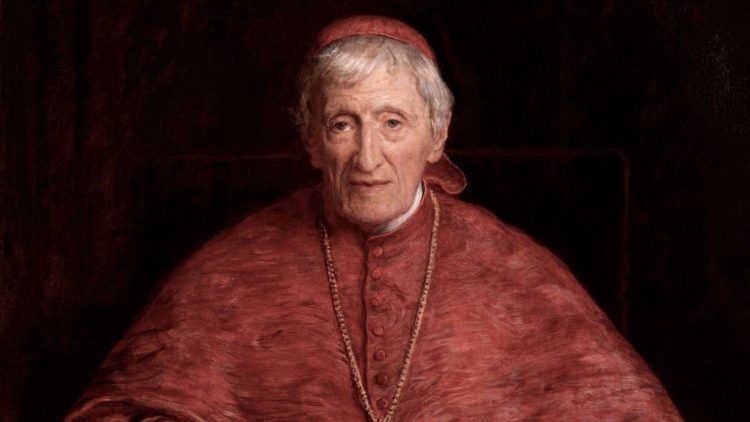
John Henry Newman: 'A Mind Alive'
By Veronica Scarisbrick and Linda Bordoni
Cardinal John Henry Newman is close to becoming Britain's first new saint since St. John Ogilvie was canonized by ��MAP���� Saint Paul VI in 1976.
The last English saints, 40 martyrs of the Reformation, were canonised in 1970.
Cardinal Newman, who was beatified by ��MAP���� Benedict XVI in 2010, was born in 1801. He was ordained as a Church of England priest and went on to found the Oxford Movement but converted to Catholicism in 1845.
He was later made a cardinal and, after he died at the age of 89, more than 15,000 people lined the streets for his funeral.
The cause for his sainthood was opened in 1958 and he was declared Venerable by ��MAP���� Saint John Paul II in 1991 after his life of ‘heroic virtue’ was recognised.
Immediately after his beatification, Monsignor Roderick Strange, a Newman scholar and author of a book entitled “John Henry Newman, A Mind Alive” spoke to Veronica Scarisbrick about the British cardinal whom he describes as one of the most significant figures of the 19th century.
“The mind was alive not because he was some icy intellectual locked in a tower, but because he didn’t want to move minds without touching hearts” explains Mons. Roderick Strange, who in an amicable and intimate chat with Veronica Scarisbrick, talks about Newman: “the thinker, the friend, the priest”.
First of all, he says, Newman “would be an example (and an inspiration) for people who struggle, whose lives are a bit complicated, a bit messy at times”, because, just as we can see in Newman’s life “that’s alright… it’s really about how we handled the mess rather than have things perfect all the while.”
The friend
Strange goes on to describe a man with a complex personality: “somebody who was in many ways quite solitary, quite happy in his own company, but also a man who had a great capacity for friendship”.
He got on well with all sorts of people, he says, “including many women friends, aristocratic ladies, his sisters, some nuns… he had a great capacity for engaging with people”.
The scholar
Remembered for being a great scholar, Strange points out that Newman’s “scholarship was always ‘occasional’- not that he just did it from time to time - but in the sense that it was provoked and prompted by particular occasions and needs. There was always something very practical and immediately pastoral about what he was concerned with”.
This salient aspect of Newman’s personality and teachings, was deeply connected, Strange explains, to his “not wanting to touch peoples’ minds without moving their hearts” meaning that his theology and his spiritual guidance “had to be real, to touch people where problems existed”.
All in all, Strange says, he was very complete man: “he was human, he was saintly, he was a theologian, he was literary figure, he was a musician (he played the violin) and he was a good parish priest.
Newman and Manning
Strange contests the parallels and contrasts that, he says, are too often made with his contemporary, Henry Edward Manning, the Archbishop of Westminster who was also a convert.
He agrees there are all sorts of parallels in the lives of the two men, but he says superficial caricatures are not really fair to either of them.
So many stories have been told about Cardinal Newman, and parallels and contrasts have been drawn with his contemporaries, but Strange reiterates at the core of his life was a strong pastoral drive that shaped everything that he did: “He wasn’t a remote academic”.
Legacy
Monsignor Strange also reflects on Newman’s legacy and on how he can help us understand questions we may puzzle over, such as questions of authority, the significance of Our Lady in ecumenical discussion, the place of the laity in the Church, as well, of course, our attitudes to spirituality and his example of faithfulness when things are difficult.
He talks at length about Newman’s friendship with Edward Pusey, who was also part of the Oxford Movement, a movement that aimed to help the Church of England retain and develop its Catholic tradition.
Strange says that Newman became a Catholic while Pusey remained an Anglican, but they remained good friends and always kept in contact. At one point, he notes, they became involved in a doctrinal controversy: “although they were holding on one hand a public debate, they were also writing to each other privately: a wonderful example of how to handle a dispute in the most constructive fashion”.
“That personal trust is a vital feature in all ecumenical – and human – relationships”, Strange says, underlining yet again, how Newman exemplified this truth and how he is still so relevant regarding so many matters that are still crucial in the Church today: “He’s not just some figure from the distant past but somebody who really does have something that is significant for us, still today”.
Thank you for reading our article. You can keep up-to-date by subscribing to our daily newsletter. Just click here






